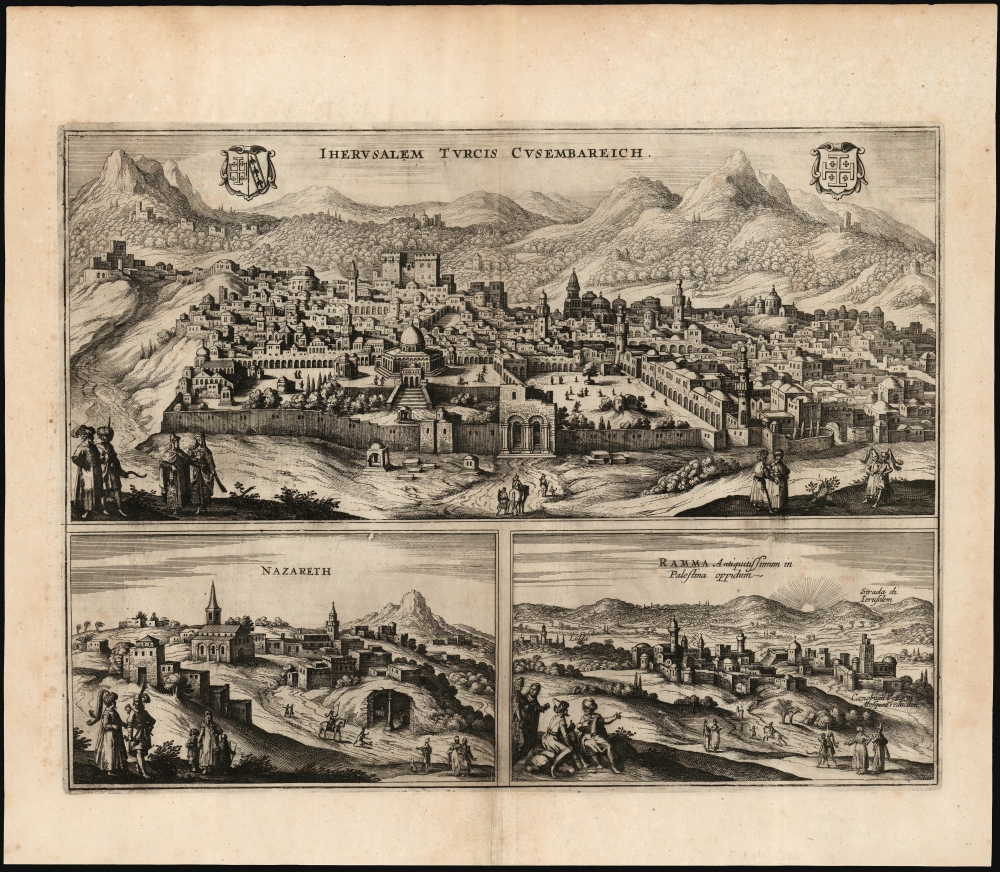This item has been sold, but you can get on the Waitlist to be notified if another example becomes available, or purchase a digital scan.
1657 Jan Jansson View of Jerusalem with Nazareth and Ramallah
Jerusalem-jansson-1657
Title
1657 (undated) 14.25 x 18.75 in (36.195 x 47.625 cm)
Description
A Closer Look
The panoramic views of the three cities are presented with mountains in the background, while in the foreground men and women are depicted in Ottoman garb. These elements, along with the absence of Biblical scenes, emphasize that Jansson's work intended to represent these locales not as they stood in the Biblical era, but the modern, Ottoman era. While there are some churches depicted - for the most part sporting the crosses of the Eastern church - most of the religious structures are topped with Muslim crescents, most notably the Al-Aqsa Mosque.This is reflected also in the toponymy of the views. Typically, for example, Jerusalem will be named in one iteration or another of its Latin form: Hierosolyma, for example, or as here, Iherusalem. The present view also includes an Arabic term, however: Cusembareich, a Latin transliteration of al-Quds al-Mubaraq. Al-Quds, literally 'The Holy,' is the Arabic term for Jerusalem and thus the appellation translates to 'Blessed Jerusalem.' The Arabic place name - and indeed, the general outline of the view itself - is derived from the woodcut appearing in Bernhard von Breydenbach's 1486 Peregrinatio in Terram Sanctam, the account of his pilgrimage to Jerusalem.
Theatrum Urbium Celebriorum
This engraving appeared only in Jansson's Theatrum Urbium Celebriorum, the only Dutch atlas to attempt a complete or near complete visual catalog of the cities and towns of Europe and the explored world. This sheet was included in the work's final volume, consisting of views of American, Asian, and African cities. In both its scope and aesthetics, it surpassed Braun and Hogenberg's Cologne-published Civitatis Orbis Terrarum and Jansson's work far outstripped his competitor Joan Blaeu's city books. The Theatrum Urbium Celebriorum would represent the peak of Jansson's atlas production.Publication History and Census
This map was engraved for inclusion in Jan Jansson's 1657 Theatrum Urbium Celebriorum, which appeared in a single edition. This engraving is rare. We see only seven separate examples listed in OCLC, and only six examples of the entire Theatrum.Cartographer
Jan Jansson or Johannes Janssonius (1588 - 1664) was born in Arnhem, Holland. He was the son of a printer and bookseller and in 1612 married into the cartographically prominent Hondius family. Following his marriage he moved to Amsterdam where he worked as a book publisher. It was not until 1616 that Jansson produced his first maps, most of which were heavily influenced by Blaeu. In the mid 1630s Jansson partnered with his brother-in-law, Henricus Hondius, to produce his important work, the eleven volume Atlas Major. About this time, Jansson's name also begins to appear on Hondius reissues of notable Mercator/Hondius atlases. Jansson's last major work was his issue of the 1646 full edition of Jansson's English Country Maps. Following Jansson's death in 1664 the company was taken over by Jansson's brother-in-law Johannes Waesberger. Waesberger adopted the name of Jansonius and published a new Atlas Contractus in two volumes with Jansson's other son-in-law Elizée Weyerstraet with the imprint 'Joannis Janssonii haeredes' in 1666. These maps also refer to the firm of Janssonius-Waesbergius. The name of Moses Pitt, an English map publisher, was added to the Janssonius-Waesbergius imprint for maps printed in England for use in Pitt's English Atlas. More by this mapmaker...

